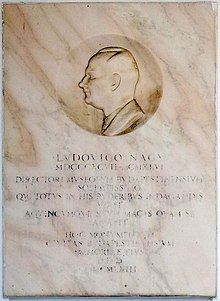Lajos Nagy (archaeologist)
Lajos Nagy (born March 15, 1897 in Großwardein , † December 10, 1946 in Budapest ) was a Hungarian provincial Roman archaeologist and art historian. He was director of the Historical Museum in Budapest .
life and work
Studies and military service
Nagy began studying as a member of the József Eötvös Collegium in 1914 at what was then the Royal Hungarian University in Budapest . From 1915 onwards he fought on the Italian and Russian fronts for almost three years during the First World War . In 1919 he joined the Hungarian Red Army as artillery commander. In July 1919, Nagy was captured by Romanian soldiers in Szolnok and imprisoned for five months in the fortress of Arad .
After his release from prison, he returned to Budapest to resume his studies. The final exams to become a history and Latin teacher took place at the end of 1920 and in 1921 he finished his studies in archeology and ancient history . At the same time he did his PhD in art history .
First professional activities
In 1921 he accepted an invitation from Bálint Kuzsinszky (1864–1938), director of the Aquincum Museum, which at that time belonged to the Budapest City Museum. There he became Kuzsinszky's partner. From 1922 to 1928 he held the position of assistant curator .
With a grant from the Italian state, Nagy was able to work at the La Sapienza University in Rome from 1925 to 1927 . In 1928 he became curator of the Aquincum Museum Budapest. Another scholarship enabled him to go on an archaeological study tour through Greece from 1929 to 1930. He also visited Malta, Tunisia and Austria.
From 1930 Lajos Nagy was habilitated as a private lecturer in Roman archeology at the Royal Hungarian University and remained in this position until 1941.
Archaeological work
Lajos Nagy directed the archaeological excavations in Aquincum since 1921 . In 1931 he found the remains of one of the oldest organs from the 3rd century. He wrote an account about it. Nagy also carried out investigations at the Szentendre Castle . In 1932 he led the first archaeological excavations at the late antique fortress Contra Aquincum . In September of the same year he took part in the third International Congress of Christian Archeology in Ravenna . In 1935 he conducted investigations at Burgus Szigetmonostor-Horány . So far there is only a short preliminary report of this exposure.
Other professional activities
In 1936, Lajos Nagy founded the Archaeological Institute at the History Museum in Budapest. The archaeologist Tibor Nagy (1910–1995) was a great support to him. When Kuzsinszky died in 1938, Lajos Nagy was appointed Museum Director of Aquincum, where he could rely on the active help of János Szilágyi (1907–1988).
In 1941 Nagy took over the position of director at the Historical Museum and held this position until his death. In the same year he became an associate professor. From 1943 he was co-editor of the archaeological journal Budapest Régiségei . A few weeks before his death, in November 1946, he was appointed full professor.
Memberships
In 1934 he was elected a corresponding member of the Hungarian Academy of Sciences . He was a full member of the Hungarian Society for Archeology and Art History (Magyar Régészeti és Művészettörténeti Társulat) since 1932 and was later elected its general secretary. From 1933 to 1937 he was a board member of the National Monument Commission (Műemlékek Országos Bizottsága). In 1945 he was elected as a member of the board of the newly founded society Archaeologica Corona. He was also a corresponding member of the German Archaeological Institute and the Archaeological Institute in Belgrade (Institut Arheološki).
In 1946 he was awarded the Flóris-Rómer Medal by the Hungarian Society for Archeology and Art History.
Posthumously
The city of Szentendre honored Nagy in 1958 by building a street named Dr. Nagy Lajos utca , named after him. This road leads to the Szentendre Castle . The Aquincum Museum dedicated a plaque to him in 1963.
Fonts (selection)
- The Roman-Pannonian decorative painting . In: Communications from the German Archaeological Institute XLI (1926), pp. 79–131.
- Az Aquincumi Orgona . (= Az Aquincumi Múzeum Kiadványa 2) Budapest 1933
- Aquincumi múmiatemetkezések (mummy burials from Aquincum) . (= Dissertationes Pannonicae ex Instituto numismatico et archaeologico universitatis a Petro Pázmány nominatae Budapestinensis provenientes ), Budapest 1935.
- Asztrális szimbólumok a pannoniai bennszülött lakosság síremlékein . In: Pannonia 1935, pp. 19-35.
- Aquincumi vonatkozású kiadatlan feliratos kőemlékek Szentendréről . In: Archaeologiai Értesítő 50 (1937), pp. 85–115.
- Temetők és temetkezés . In: Budapest története 2 (1942) p. 464-485.
- Kiadatlan rómaikori eraviszkus síremlékek Szentendréről (Unpublished Erawiskische funerary monuments of the Roman period from Szentendre-Ulcisia Castra) . In: Archaeologiai Értesítő 4 (1943) pp. 87–9.
- Az Eskü-téri római erőd, Pest város őse (The Roman fortress on Eskü Square, the predecessor of the city of Pest). Budapest Székesfőváros Irodalmi és Művészeti Intézet Kiadása, Budapest 1946
literature
- N [agy] T [ibor]: Nagy Lajos 1897-1946 . Antiquitas Hungarica 1 (1947) 105-106.
- Nagy Lajos . In: Ferenc Glatz (Ed.): A Magyar Tudományos Akadémia tagjai. 1825-2002 . Volume 2, MTA Társadalomkutató Központ-Tudománytár, Budapest 2003, p. 914.
Remarks
- ↑ Lajos Nagy: A pannóniai falfestés emlékei . dissertation
- ↑ Reconstruction of the Aquincum organ in 1970
- ^ Zsolt Visy : The Pannonian Limes in Hungary . Theiss, Stuttgart 1988, ISBN 3-8062-0488-8 , p. 85.
- ^ Barnabás Lőrincz : A későrómai hídfőállások bélyeges téglái Valeriában. In: Attila Gaál (Ed.): Pannoniai kutatások. A Soproni Sándor emlékkonferencia előadásai (Bölcske, 1998. October 7th) . Szekszárd 1999, pp. 53-68.
| personal data | |
|---|---|
| SURNAME | Nagy, Lajos |
| BRIEF DESCRIPTION | Hungarian provincial Roman archaeologist and art historian |
| DATE OF BIRTH | March 15, 1897 |
| PLACE OF BIRTH | Oradein |
| DATE OF DEATH | December 10, 1946 |
| Place of death | Budapest |
